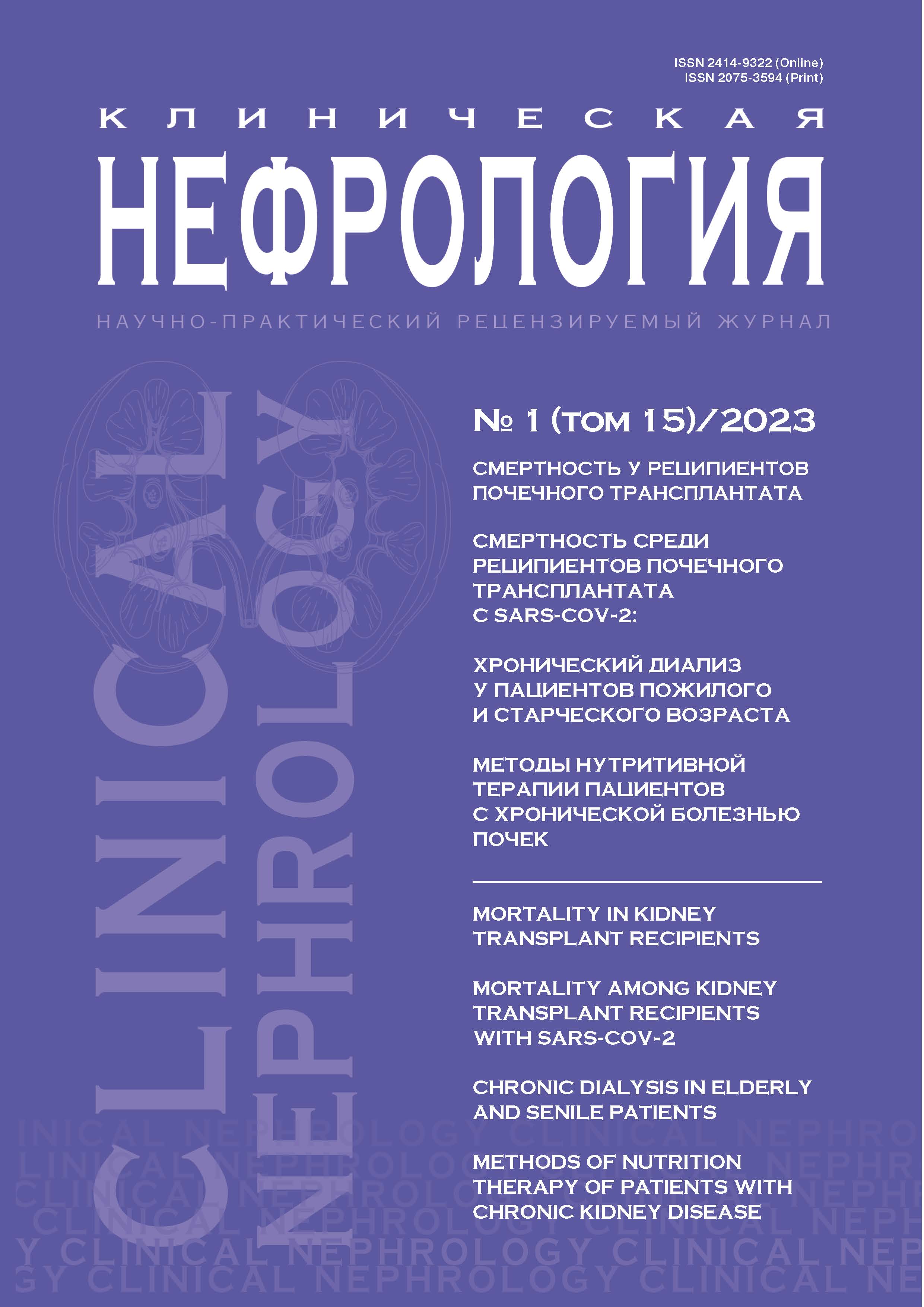Chronic dialysis in elderly and senile patients: survival and factors affecting outcome. Single-center experience
- Авторлар: Kurilovich K.A.1,2, Komissarov K.S.3, Krasko O.V.4
-
Мекемелер:
- 1st City Clinical Hospital
- Belarusian Medical Academy of Postgraduate Education
- Minsk Scientific and Practical Center for Surgery, Transplantology and Hematology
- Joint Institute for Informatics Problems of the National Academy of Sciences of Belarus
- Шығарылым: Том 15, № 1 (2023)
- Беттер: 58-64
- Бөлім: Original Articles
- ##submission.datePublished##: 20.05.2023
- URL: https://journals.eco-vector.com/2075-3594/article/view/430430
- DOI: https://doi.org/10.18565/nephrology.2023.1.58-64
- ID: 430430
Дәйексөз келтіру
Аннотация
Objective. Evaluation of the survival and mortality predictors in patients ≥60 years of age on chronic dialysis (CD).
Material and methods. Data analysis of 199 patients ≥60 years of age on CD: 183 (92%) on program hemodialysis (PHD),
16 (8%) on continuous ambulatory peritoneal dialysis (CAPD).
Results. Median survival was 279 days for PHD, and 650 for CAPD; 1-year survival for PHD was 46.5±3.8%, for CAPD – 81.2±9.8%, 2-year survival for PHD was 33, 3±3.9%, for CAPD – 37.2±13%. Univariate analysis of mortality predictors: PHD vs CAPD method (hazard ratio – RR=1.9, 95% confidence interval – CI 1.04-3.6), age (RR=1.7, 95% CI 1.1-2.6), the presence of type 2 diabetes mellitus – DM2 (RR=1.5, 95% CI 1.1–2.2), the presence of overhydration (RR =1.7, 95% CI 1.2–2.4), pre-dialysis creatinine (Cr) (RR=1.1, 95% CI 1.03–1.2) and urea levels (RR=1.04, 95% CI 1.02–1.05). Multivariate analysis of mortality predictors: age, at the first year of treatment: Cr>1000 µmol/L, urea>45 mmol/L, start of renal replacement therapy (RRT) by PHD.
Conclusion. The peak of mortality in elderly patients occurs in the first year of PHD. CAPD can be considered as 1st line RRT in patients ≥60 years of age. To improve the first year survival of patients on RRT, further study of mortality predictors is required.
Негізгі сөздер
Толық мәтін
Авторлар туралы
Kristina Kurilovich
1st City Clinical Hospital; Belarusian Medical Academy of Postgraduate Education
Хат алмасуға жауапты Автор.
Email: cn@bionika-media.ru
ORCID iD: 0000-0002-9112-4863
Белоруссия, Minsk; Minsk
Kirill Komissarov
Minsk Scientific and Practical Center for Surgery, Transplantology and Hematology
Email: cn@bionika-media.ru
ORCID iD: 0000-0002-2648-0642
Белоруссия, Minsk
Olga Krasko
Joint Institute for Informatics Problems of the National Academy of Sciences of Belarus
Email: cn@bionika-media.ru
ORCID iD: 0000-0002-4150-282X
Белоруссия, Minsk
Әдебиет тізімі
- Chan C.T., Blankestijn P.J., Dember L.M., et al. Dialysis initiation, modality choice, access, and prescription: conclusions from a Kidney Disease: Improving Global Outcomes (KDIGO) Controversies Conference. Kidney Int. 2019;96(1):37–47. doi: 10.1016/j.kint.2019.01.017.
- Ageing [Electronic resource]/United Nations. Mode of access: https://www.un.org/en/global-issues/ageing. Date of access: 24.01.2023.
- Santos J., Oliveira P., Malheiro J., et al. Predicting 6-month mortality in incident elderly dialysis patients: a simple prognostic score. Kidney Blood Press. Res. 2020;45:38–50. doi: 10.1159/000504136.
- Inker L.A., Eneanya N.D., Coresh J., et al. New creatinine- and cystatin C-based equations to estimate GFR without race assessment of optimally selected prognostic factors. N. Engl. J. Med. 2021;385:1737–49. doi: 10.1056/NEJMoa2102953.
- Nuttall F.Q. Body mass index: obesity, BMI, and health: A Critical Review. Nutr. Today. 2015;50(3):117–28. doi: 10.1097/NT.0000000000000092.
- Segall L., Nistor I., Van Biesen W., et al. Dialysis modality choice in elderly patients with end-stage renal disease: a narrative review of the available evidence. Nephrol. Dial. Transplant. 2017;32(1):41–9. doi: 10.1093/ndt/gfv411.
- Song Y.H., Cai G.Y., Xiao Y.F., et al. Risk factors for mortality in elderly haemodialysis patients: a systematic review and meta-analysis. BMC. Nephrol. 2020;21(1):377. doi: 10.1186/s12882-020-02026-x.
- Silva A.T., Hauschild D.B., Oliveira L.D. de A., et al. Association of hyperhydration evaluated by bioelectrical impedance analysis and mortality in patients with different medical conditions: Systematic review and meta-analyses. Clin. Nutrit. ESPEN. 2018;28:12–20. doi: 10.1016/j.clnesp.2018.08.022.
- Zemaitis M. R., Foris L. A., Katta S., et al. Uremia. Treasure Island (FL): StatPearls Publish. 2022.
- García G.G., Iyengar A., Kaze F., et al. Sex and gender differences in chronic kidney disease and access to care around the globe. Semin. Nephrol. 2022;42(2):101–13. doi: 10.1016/j.semnephrol.2022.04.001.
- Maddux D. Sex Differences in Chronic Kidney Disease [Electronic resource]/Fresenius Medical Care. Mode of access: https://fmcna.com/insights/articles/sex-differences-chronic-kidney-disease. Date of access: 24.01.2023.
- You A.S., Kalantar-Zadeh K., Obi Y., et al. Residual urine output and mortality in a prospective hemodialysis cohort. Kidney Int. Rep. 2020;5(5):643–53. doi: 10.1016/j.ekir.2020.02.002.
- Wachterman M.W., O’Hare A.M., Rahman O., et al. One-year mortality after dialysis initiation among older adults. JAMA. Intern. Med. 2019;179(7):987–90. doi: 10.1001/jamainternmed.2019.0125.
- Oki R., Hamasaki Y., Tsuji S., et al. Clinical frailty assessment might be associated with mortality in incident dialysis patients. Sci. Rep. 2022;12:17651. doi: 10.1038/s41598-022-22483-8.









